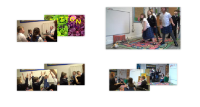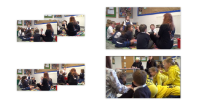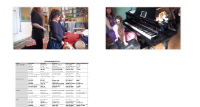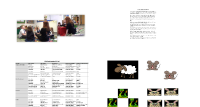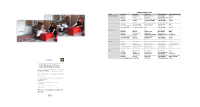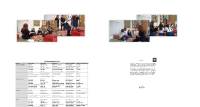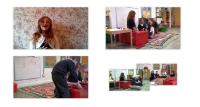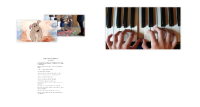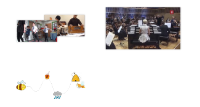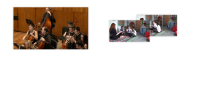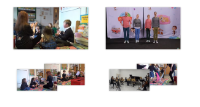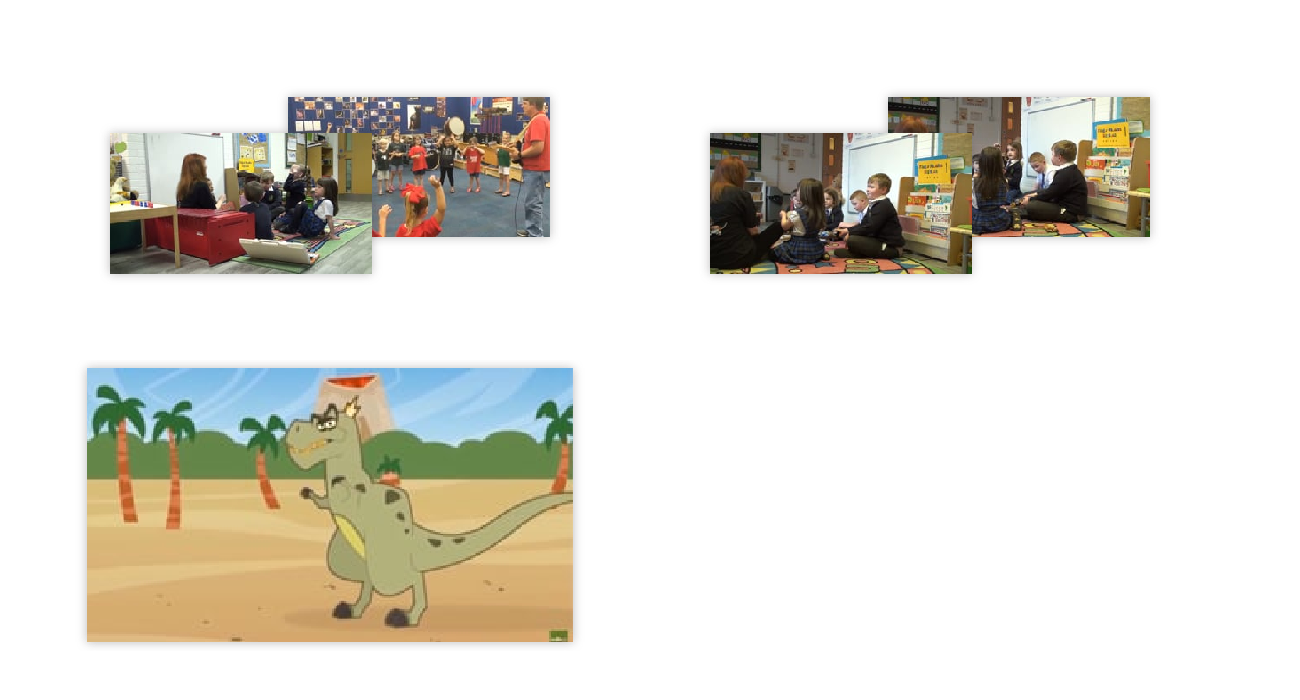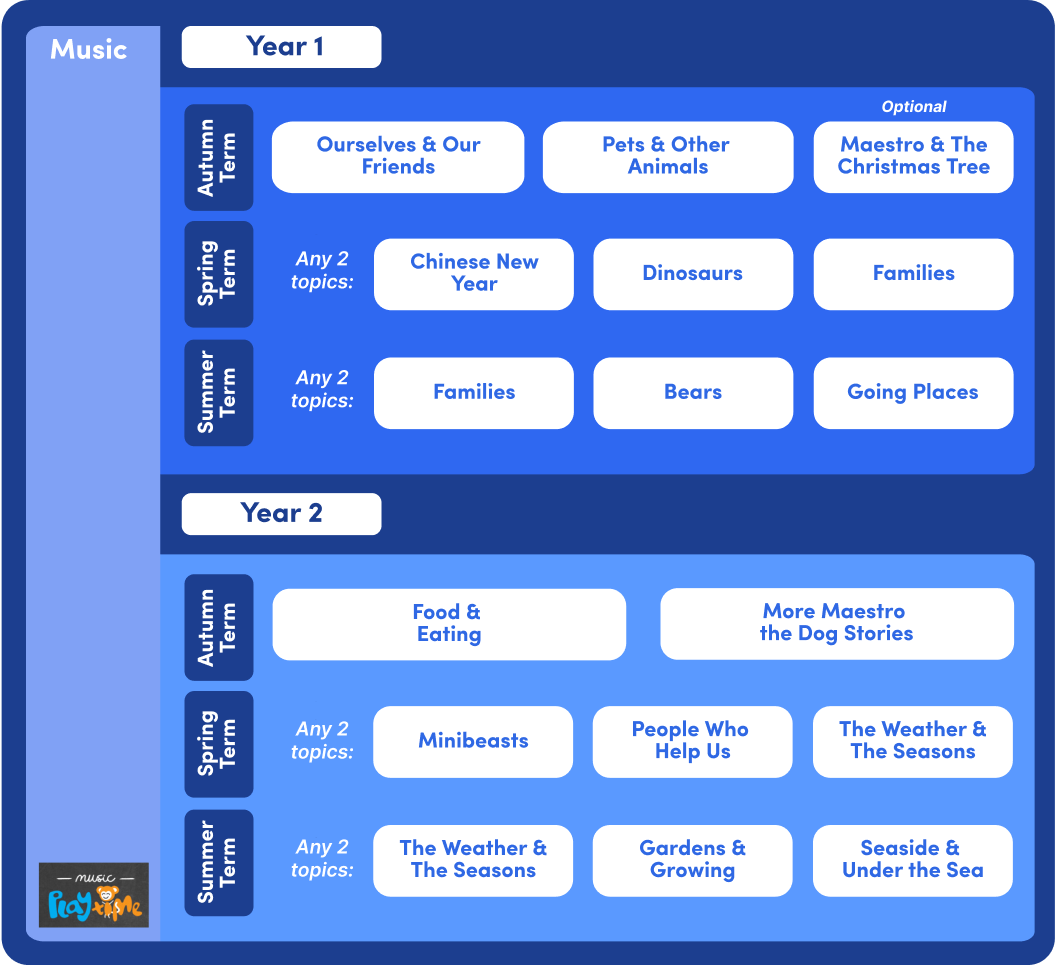Dinosaurs Level: Key Stage 1
Music Unit Description
This unit is about dinosaurs and other extinct animals, focusing on high and low pitch, clapping rhythms and keeping a steady pulse.
Elements
- Duration: Long or short notes, RHYTHM.
- Tempo: Fast or slow speed of the PULSE, or BEAT
- Pitch: High pitched and low pitched sounds.
Resources
- Book: Goldilocks and the Three Dinosaurs – Mo Willems ISBN: 9780062104182 Publisher: Harper Collins
- Tuned and untuned percussion instruments
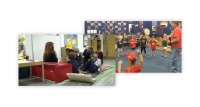
High and Low Pitch
After I'd used the word, pitch with the children several times, I was thrilled to hear India use the term spontaneously to comment on the tune of a song we were singing. Introducing the right vocabulary in context really does promote understanding. I took the opportunity to explore with the children the physical properties of pitch in relation to the xylophone, and left it out so that they could experiment individually after the lesson.
Which dinosaur would make the lowest pitch sound and which would make the highest pitch sound? Bigger things and longer things generally make the lowest sounds and the children can test this out in different contexts, for example using the piano strings or even different sized saucepans that are made of the same material. Boomwhackers are good fun too - they are tuned to specific pitches, just like chime bars.

In my set, the short red one is higher C and the long red one is lower C. It can be a bit confusing at first because the tallest boomwhacker makes the lowest sound and, at first, children can confuse 'tall' (height) with 'high' (pitch)!
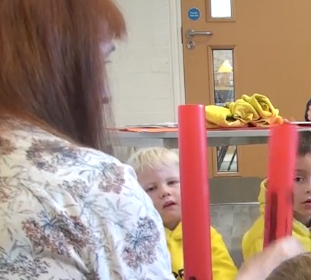
Here's an activity that any teacher could do, using a set of chime bars or a big xylophone. It helps the children to understand high and low pitch. Children need plenty of reinforcement about the meaning of high and low pitch as opposed to high and low volume (dynamics) so it's best to be consistent when you use the words loud and quiet for dynamics and high and low for pitch.

The Microceratus Song
This song used ascending, then descending pitch. This dinosaur is sometimes called the microceratops. It helps if the teacher uses hand movements to show where the pitch goes up and where it goes down, with the children copying. You could play it on chime bars or a xylophone to accompany the singing, starting on C. Aim to use the correct terms for these instruments:
- A xylophone has bars made of wood
- Chime bars, metallophones and glockenspiels have metal bars
- A microceratus climbed a tree
- He wanted to be as high as can be
- __
- The microceratus slid back down
- He wanted to be back on the ground

Wish I Had a Dinosaur
This is one of our favorite songs!
- Wish I had a dinosaur
- Wish I had a dinosaur
- Wish I had a dinosaur
- To play with every day
- __
- I don't want a monkey, a mouse or a frog
- I don't want a donkey, a cat or a dog
- __
- Wish I had a dinosaur
- Wish I had a dinosaur
- Wish I had a dinosaur
- To play with every day
- __
- Dinosaur Songs ©Music-Playtime: Arts Enterprise Limited
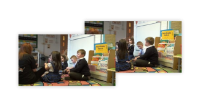
Extinction Rap (rhythm, pulse)
These rap with body percussion activities are just as easy to do with individual children, with groups or with the whole class. First the children need to practise saying the names of these extinct animals, keeping a steady pulse:
- Auk
- Do-do
- Din-o-saur
- Woo-lly mamm-oth
Next play the backing track below for the children to practise say the words in time to it, making a rap, either in groups or individually. The backing track is the right length for saying the four animal names lots of times and you'll know when you get near the end because there's an extra drum added to the mix. The children will need to practise several times and then you can record their rap and play it back to them. Either you or the children can invent body percussion or practise walking in time on the spot.
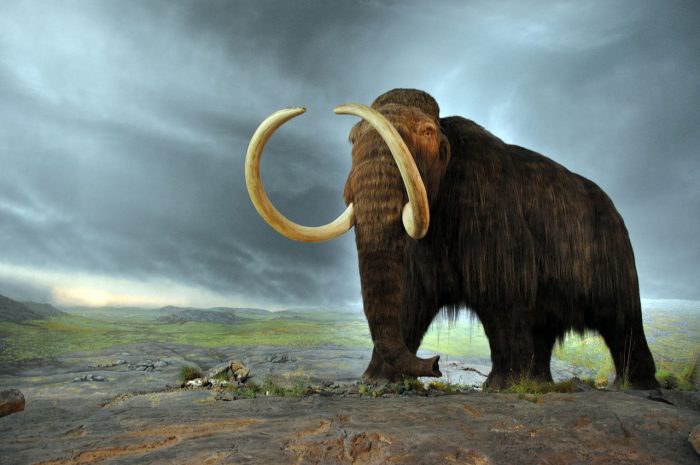

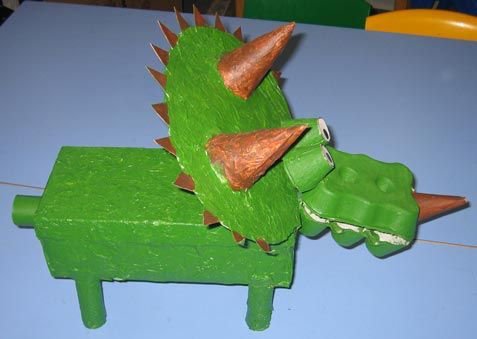
The Dinosaurs Escape! (timbre, dynamics)
First, tell this story about dinosaurs escaping from a zoo:
The dinosaurs were very sad that they lived in a zoo. One day the littlest dinosaur had an idea - they would escape! The big dinosaurs roared with laughter at this idea at first, but then they started whispering about how to make their escape. When the day came, the big dinosaurs and the flying dinosaurs let the little ones ride on their backs as they pushed down the walls of their enclosure. The zoo-keepers were angry! The last time we saw the dinosaurs they were happily flying into the sky or running away free!
When you do this with a whole class, pairs or small groups of children could first go to the music corner, with an adult helper, to choose instruments for their part of the story eg the angry zoo-keeper. The children then accompany the story with instruments as the teacher tells it again. If you are doing this with just a group, there is enough time for choosing instruments and experimenting with playing them to fit the story.
Extension Activity (structure, texture)
In small, supervised groups or pairs the children make the sequence of sounds that go with each part of the story, but without the words being said. They really have to think about how the story and the music are structured. I've taken the opportunity here to mention the element of music term, texture in relation to our music.
Alternatively, the children could make up their own story to set to music.

The Dinosaurs Escape Again! (tempo, pitch, timbre)
First the teacher explains that the music is about dinosaurs escaping from their zoo and the children listen quietly.
Things to talk about after listening
The questions are followed by suggested answers, but do accept all answers as valid:
Q - Does this music sound as if the dinosaurs are running away? Why do you think that?
- Low pitch notes could be the big dinosaurs.
- The tempo (speed) is quite quick.
- The tune sometimes sounds like 'running'.
- Short, jumpy notes (staccato notes) make it sound lively.
Q – Was the music the same all through or did it change?
- It changed - can the children describe in what way?
Q - Did you hear drums in the middle part and near the end? (Listen again and 'hands up' when you hear them)
Q - Do you think there was any danger for the dinosaurs or for the people? Which part of the music sounds scary? Raise hands when you think it's scary!
Q - Do you think they made their escape?
- The high pitch notes at the end sound hopeful!


Let's Do Dinosaurs!
Dinosaur Models (art & craft)
Use cardboard boxes and tubes then paint your monster green.

Fun Dinosaurs Facts (science)
Story Book (literacy)
Goldilocks and the Three Dinosaurs – Mo Willems ISBN: 9780062104182 Publisher: Harper Collins
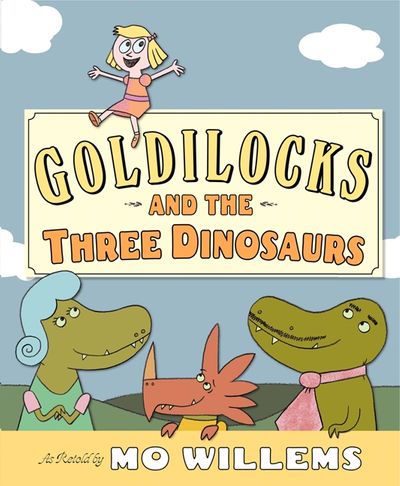

High and Low Pitch
After I'd used the word, pitch with the children several times, I was thrilled to hear India use the term spontaneously to comment on the tune of a song we were singing. Introducing the right vocabulary in context really does promote understanding. I took the opportunity to explore with the children the physical properties of pitch in relation to the xylophone, and left it out so that they could experiment individually after the lesson.
Which dinosaur would make the lowest pitch sound and which would make the highest pitch sound? Bigger things and longer things generally make the lowest sounds and the children can test this out in different contexts, for example using the piano strings or even different sized saucepans that are made of the same material. Boomwhackers are good fun too - they are tuned to specific pitches, just like chime bars.

In my set, the short red one is higher C and the long red one is lower C. It can be a bit confusing at first because the tallest boomwhacker makes the lowest sound and, at first, children can confuse 'tall' (height) with 'high' (pitch)!

Here's an activity that any teacher could do, using a set of chime bars or a big xylophone. It helps the children to understand high and low pitch. Children need plenty of reinforcement about the meaning of high and low pitch as opposed to high and low volume (dynamics) so it's best to be consistent when you use the words loud and quiet for dynamics and high and low for pitch.

The Microceratus Song
This song used ascending, then descending pitch. This dinosaur is sometimes called the microceratops. It helps if the teacher uses hand movements to show where the pitch goes up and where it goes down, with the children copying. You could play it on chime bars or a xylophone to accompany the singing, starting on C. Aim to use the correct terms for these instruments:
- A xylophone has bars made of wood
- Chime bars, metallophones and glockenspiels have metal bars
- A microceratus climbed a tree
- He wanted to be as high as can be
- __
- The microceratus slid back down
- He wanted to be back on the ground

Wish I Had a Dinosaur
This is one of our favorite songs!
- Wish I had a dinosaur
- Wish I had a dinosaur
- Wish I had a dinosaur
- To play with every day
- __
- I don't want a monkey, a mouse or a frog
- I don't want a donkey, a cat or a dog
- __
- Wish I had a dinosaur
- Wish I had a dinosaur
- Wish I had a dinosaur
- To play with every day
- __
- Dinosaur Songs ©Music-Playtime: Arts Enterprise Limited

Extinction Rap (rhythm, pulse)
These rap with body percussion activities are just as easy to do with individual children, with groups or with the whole class. First the children need to practise saying the names of these extinct animals, keeping a steady pulse:
- Auk
- Do-do
- Din-o-saur
- Woo-lly mamm-oth
Next play the backing track below for the children to practise say the words in time to it, making a rap, either in groups or individually. The backing track is the right length for saying the four animal names lots of times and you'll know when you get near the end because there's an extra drum added to the mix. The children will need to practise several times and then you can record their rap and play it back to them. Either you or the children can invent body percussion or practise walking in time on the spot.



The Dinosaurs Escape! (timbre, dynamics)
First, tell this story about dinosaurs escaping from a zoo:
The dinosaurs were very sad that they lived in a zoo. One day the littlest dinosaur had an idea - they would escape! The big dinosaurs roared with laughter at this idea at first, but then they started whispering about how to make their escape. When the day came, the big dinosaurs and the flying dinosaurs let the little ones ride on their backs as they pushed down the walls of their enclosure. The zoo-keepers were angry! The last time we saw the dinosaurs they were happily flying into the sky or running away free!
When you do this with a whole class, pairs or small groups of children could first go to the music corner, with an adult helper, to choose instruments for their part of the story eg the angry zoo-keeper. The children then accompany the story with instruments as the teacher tells it again. If you are doing this with just a group, there is enough time for choosing instruments and experimenting with playing them to fit the story.
Extension Activity (structure, texture)
In small, supervised groups or pairs the children make the sequence of sounds that go with each part of the story, but without the words being said. They really have to think about how the story and the music are structured. I've taken the opportunity here to mention the element of music term, texture in relation to our music.
Alternatively, the children could make up their own story to set to music.

The Dinosaurs Escape Again! (tempo, pitch, timbre)
First the teacher explains that the music is about dinosaurs escaping from their zoo and the children listen quietly.
Things to talk about after listening
The questions are followed by suggested answers, but do accept all answers as valid:
Q - Does this music sound as if the dinosaurs are running away? Why do you think that?
- Low pitch notes could be the big dinosaurs.
- The tempo (speed) is quite quick.
- The tune sometimes sounds like 'running'.
- Short, jumpy notes (staccato notes) make it sound lively.
Q – Was the music the same all through or did it change?
- It changed - can the children describe in what way?
Q - Did you hear drums in the middle part and near the end? (Listen again and 'hands up' when you hear them)
Q - Do you think there was any danger for the dinosaurs or for the people? Which part of the music sounds scary? Raise hands when you think it's scary!
Q - Do you think they made their escape?
- The high pitch notes at the end sound hopeful!


Let's Do Dinosaurs!
Dinosaur Models (art & craft)
Use cardboard boxes and tubes then paint your monster green.

Fun Dinosaurs Facts (science)
Story Book (literacy)
Goldilocks and the Three Dinosaurs – Mo Willems ISBN: 9780062104182 Publisher: Harper Collins

